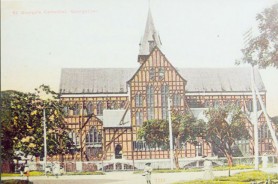We are accustomed to seeing a white, almost ethereal St George’s with a silver spire soaring to the sky, but it did not always look like that. Those who are familiar with the interior of the building will know that it is designed with a half-timbering effect, and originally this was repeated on the outside of the structure as well. This ‘decoration’ was eventually removed because it was said to be too heavy for the walls to support. The photo above shows St George’s as those who lived at the end of the 19th and in the first decades of the 20th century would have seen it.

Erecting a new cathedral could be postponed no longer after the old one came to pose a danger, and in 1877, what was called a pro-cathedral was put up, pending the erection of a new building. This new building was the current St George’s, work on which began in 1889. It was dedicated in 1892, and opened for worship the following year.
At the time Rodway was writing, the exterior was still carrying its superstructure, which is

why, perhaps, he writes, “It is generally admitted that this [the cathedral] is ugly, and it is certainly not waterproof… and no doubt some means will shortly be found to make the external appearance a little more pleasing.” A means was found to make the external appearance infinitely “more pleasing,” although this does not seem to have been done with aesthetics primarily in mind.




